My ride was a 1952 Pontiac. Nice.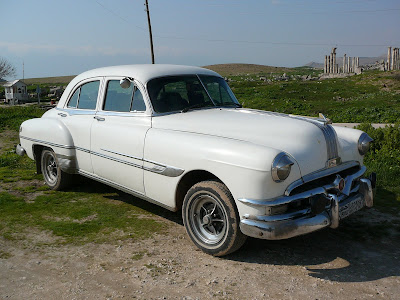 First stop was the mosaic floor of (the church) Tayibat Al-Imam, which is one of the most important and intact mosaics in Syria. It is huge!!!
First stop was the mosaic floor of (the church) Tayibat Al-Imam, which is one of the most important and intact mosaics in Syria. It is huge!!!





 The next stop was the mosaic museum. Syria has some amazing mosaics!!! They are made using tiny square shaped stones of different colors. Some have such amazing details!
The next stop was the mosaic museum. Syria has some amazing mosaics!!! They are made using tiny square shaped stones of different colors. Some have such amazing details! 
 The museum is in an old Caravanserai.
The museum is in an old Caravanserai. 
 The first dead city I went to is Serjilla.
The first dead city I went to is Serjilla.  It was quite eerie with the wind blowing across the moors and only a few people - all of whom were Syrians, mostly children. Wandering about the ruins was very interesting.
It was quite eerie with the wind blowing across the moors and only a few people - all of whom were Syrians, mostly children. Wandering about the ruins was very interesting. I was amused by the children... though maybe not as much as they were amused by me!! It started out with one boy following me, then one by one more joined. They were polite, and would try their best not to be infront of me, or where I was taking pictures. One girl wanted a picture with me on her cellphone. By the time I finished my walk around the dead city, I had about a dozen kids following me. The first boy disappeared at one point and returned with a small turtle. Not sure where that came from.
I was amused by the children... though maybe not as much as they were amused by me!! It started out with one boy following me, then one by one more joined. They were polite, and would try their best not to be infront of me, or where I was taking pictures. One girl wanted a picture with me on her cellphone. By the time I finished my walk around the dead city, I had about a dozen kids following me. The first boy disappeared at one point and returned with a small turtle. Not sure where that came from. 
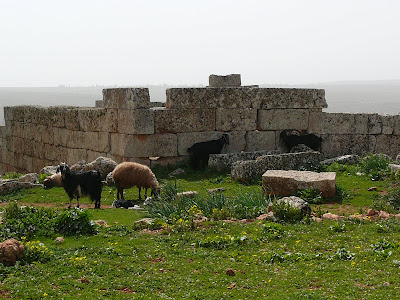 A couple of the girls kept asking my name and how are you, and saying nice to meet you. I think that is all they knew. Cute. The only picture I have of them is near the end when I turned around to take a picture of the dead city as a whole and they were all right there behind me.
A couple of the girls kept asking my name and how are you, and saying nice to meet you. I think that is all they knew. Cute. The only picture I have of them is near the end when I turned around to take a picture of the dead city as a whole and they were all right there behind me. Next I went to the dead city of Al Bara. I only got to see a few things at this one as it seems to be a bit more spread out and is now all orchards.
Next I went to the dead city of Al Bara. I only got to see a few things at this one as it seems to be a bit more spread out and is now all orchards.  Al Bara is, I think, the most extensive of the dead cities.
Al Bara is, I think, the most extensive of the dead cities. 
 I saw 2 pyramid tombs
I saw 2 pyramid tombs  (one big, one small)
(one big, one small)  and one monastery.
and one monastery. 





 For some reason, the driver didn't want me to wander about any more of it. :(
For some reason, the driver didn't want me to wander about any more of it. :( 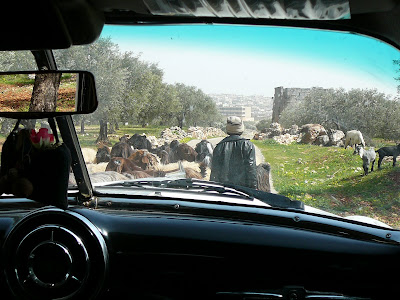 The area was amazing. As we drove, the landscape kept changing. In some areas, there were little red poppies everywhere. Very cool.
The area was amazing. As we drove, the landscape kept changing. In some areas, there were little red poppies everywhere. Very cool.  Apamea (pronounced Afamea) was great. The ruins stretch along 1.8 km.
Apamea (pronounced Afamea) was great. The ruins stretch along 1.8 km.  When I arrived, another vehicle arrived. I was invited to join Dave and his guide (Farid?) on their walk through the area. Dave is traveling with the guide (and has traveled with the same guide in other countries at other times, including Turkey and Iran). I can't imagine how much a guide like that would cost!!
When I arrived, another vehicle arrived. I was invited to join Dave and his guide (Farid?) on their walk through the area. Dave is traveling with the guide (and has traveled with the same guide in other countries at other times, including Turkey and Iran). I can't imagine how much a guide like that would cost!! 
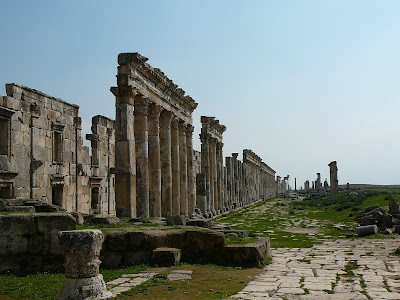

 First stop was the mosaic floor of (the church) Tayibat Al-Imam, which is one of the most important and intact mosaics in Syria. It is huge!!!
First stop was the mosaic floor of (the church) Tayibat Al-Imam, which is one of the most important and intact mosaics in Syria. It is huge!!!





 The next stop was the mosaic museum. Syria has some amazing mosaics!!! They are made using tiny square shaped stones of different colors. Some have such amazing details!
The next stop was the mosaic museum. Syria has some amazing mosaics!!! They are made using tiny square shaped stones of different colors. Some have such amazing details! 
 The museum is in an old Caravanserai.
The museum is in an old Caravanserai. 
 The first dead city I went to is Serjilla.
The first dead city I went to is Serjilla.  It was quite eerie with the wind blowing across the moors and only a few people - all of whom were Syrians, mostly children. Wandering about the ruins was very interesting.
It was quite eerie with the wind blowing across the moors and only a few people - all of whom were Syrians, mostly children. Wandering about the ruins was very interesting. I was amused by the children... though maybe not as much as they were amused by me!! It started out with one boy following me, then one by one more joined. They were polite, and would try their best not to be infront of me, or where I was taking pictures. One girl wanted a picture with me on her cellphone. By the time I finished my walk around the dead city, I had about a dozen kids following me. The first boy disappeared at one point and returned with a small turtle. Not sure where that came from.
I was amused by the children... though maybe not as much as they were amused by me!! It started out with one boy following me, then one by one more joined. They were polite, and would try their best not to be infront of me, or where I was taking pictures. One girl wanted a picture with me on her cellphone. By the time I finished my walk around the dead city, I had about a dozen kids following me. The first boy disappeared at one point and returned with a small turtle. Not sure where that came from. 
 A couple of the girls kept asking my name and how are you, and saying nice to meet you. I think that is all they knew. Cute. The only picture I have of them is near the end when I turned around to take a picture of the dead city as a whole and they were all right there behind me.
A couple of the girls kept asking my name and how are you, and saying nice to meet you. I think that is all they knew. Cute. The only picture I have of them is near the end when I turned around to take a picture of the dead city as a whole and they were all right there behind me. Next I went to the dead city of Al Bara. I only got to see a few things at this one as it seems to be a bit more spread out and is now all orchards.
Next I went to the dead city of Al Bara. I only got to see a few things at this one as it seems to be a bit more spread out and is now all orchards.  Al Bara is, I think, the most extensive of the dead cities.
Al Bara is, I think, the most extensive of the dead cities. 
 I saw 2 pyramid tombs
I saw 2 pyramid tombs  (one big, one small)
(one big, one small)  and one monastery.
and one monastery. 





 For some reason, the driver didn't want me to wander about any more of it. :(
For some reason, the driver didn't want me to wander about any more of it. :(  The area was amazing. As we drove, the landscape kept changing. In some areas, there were little red poppies everywhere. Very cool.
The area was amazing. As we drove, the landscape kept changing. In some areas, there were little red poppies everywhere. Very cool.  Apamea (pronounced Afamea) was great. The ruins stretch along 1.8 km.
Apamea (pronounced Afamea) was great. The ruins stretch along 1.8 km.  When I arrived, another vehicle arrived. I was invited to join Dave and his guide (Farid?) on their walk through the area. Dave is traveling with the guide (and has traveled with the same guide in other countries at other times, including Turkey and Iran). I can't imagine how much a guide like that would cost!!
When I arrived, another vehicle arrived. I was invited to join Dave and his guide (Farid?) on their walk through the area. Dave is traveling with the guide (and has traveled with the same guide in other countries at other times, including Turkey and Iran). I can't imagine how much a guide like that would cost!! 


The Main Street
The main street stretched from north to south is about 2 km. Fifteen minor roads divided it from east to west. Huge columns 10 meters high lined the street on either side, each column was three meters distance from the other, followed by the shadowy porticoes and decorated also with columns having different carvines (spiral, square and circluar). Their crowns were decoreted with Hellenistic art. The columns which lined the two sides of the street number 1200. They were ornamented with beautiful squares.
[from a board at the entrance]


 Here you can see some of the pipes of the aqueduct leading into resevoirs.
Here you can see some of the pipes of the aqueduct leading into resevoirs.
 The pillar in the middle of the road is sort of a roundabout/traffic circle. It is one of the main intersections of the road. That was the most informative tour I've ever been on!!! The things that Farid pointed out were fantastic, and some very interesting (the female - center of the floral decoration at top of pillar
The pillar in the middle of the road is sort of a roundabout/traffic circle. It is one of the main intersections of the road. That was the most informative tour I've ever been on!!! The things that Farid pointed out were fantastic, and some very interesting (the female - center of the floral decoration at top of pillar  and male - many pillars later on the top
and male - many pillars later on the top  genitalia up on the pillars, for example). Things that most people would never notice. The aqueduct systems there are very cool to see. Many things are still being uncovered and discovered in Apamea.
genitalia up on the pillars, for example). Things that most people would never notice. The aqueduct systems there are very cool to see. Many things are still being uncovered and discovered in Apamea. 

 a citadel/castle in the distance. You can see clothes lines hung up along the tops of the walls. Many Syrians have made home out of the remaining structures of this citadel. I think that would be a cool place to grow up (in a way).
a citadel/castle in the distance. You can see clothes lines hung up along the tops of the walls. Many Syrians have made home out of the remaining structures of this citadel. I think that would be a cool place to grow up (in a way). 
 The Apamea Museum in the town nearby is small but nice. It is in an old caravanserai (as are the souqs everywhere here).
The Apamea Museum in the town nearby is small but nice. It is in an old caravanserai (as are the souqs everywhere here).  On one side of the walk way through the building, there is a place to tie the animals, with a place for camp with a chimney opposite that.
On one side of the walk way through the building, there is a place to tie the animals, with a place for camp with a chimney opposite that. 
 The museum is mostly just mosaics (with a few other artifacts thrown in here and there) from the surrounding areas.
The museum is mostly just mosaics (with a few other artifacts thrown in here and there) from the surrounding areas.  The man at the museum (said he was the curator/caretaker) explained that this would have contained the bones of a saint. They would put oil in a top hole and it would go through the bones and drip out of a little spout on the side. The holy oil was used to make a cross on the forehead and for other uses as well. The sign says, "A Holy Crave - In ts covering a hole to put in oil and mix with the bones of the sant and go out from sideway a holy oil. Its date 483A.D. From Hawarty"
The man at the museum (said he was the curator/caretaker) explained that this would have contained the bones of a saint. They would put oil in a top hole and it would go through the bones and drip out of a little spout on the side. The holy oil was used to make a cross on the forehead and for other uses as well. The sign says, "A Holy Crave - In ts covering a hole to put in oil and mix with the bones of the sant and go out from sideway a holy oil. Its date 483A.D. From Hawarty" After the museum we stopped at an amphitheater. It is huge, but mostly crumbled and buried.
After the museum we stopped at an amphitheater. It is huge, but mostly crumbled and buried.My day tour was supposed to include the Sheizar Citadel (castle) but didn't!!! My driver was going to turn in to it, but didn't and said it was closed. What??? He could have at least stopped outsided and I could have checked some of it out, even if it was just from the outside. I was quite angry, actually. The trip was not cheap since I was the only one. If I had known I wouldn't have been able to see everything, I would have waited and gone the next day (leaving earlier). GRRRR. The driver didn't even stop at any point for me to get lunch. By the time I got back to the hotel at around 4 I was starving (I had been told that I would get back after sunset in order to see everything).
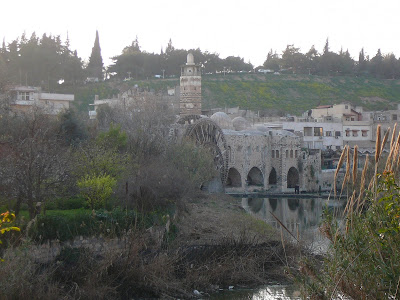 I went for a walk with Gilles, a fellow traveler staying at the hotel (met him on the trip to Krad des Chevaliers the previous day) for some chicken shawarma. We sat in the nearby park to eat and watch people go by. It is surprising how many fair skinned/haired Syrians there are. There were many very blond kids.
I went for a walk with Gilles, a fellow traveler staying at the hotel (met him on the trip to Krad des Chevaliers the previous day) for some chicken shawarma. We sat in the nearby park to eat and watch people go by. It is surprising how many fair skinned/haired Syrians there are. There were many very blond kids. 
 Then we walked up to the Citadel. Not much up there. Pretty much just a park. The citadel/castle that used to be there was completely destroyed in earthquakes. A lot of it was either carried away to be used in construction elsewhere, or buried. There was, of course, a nice view of the entire city though. As usual I had people watching me, often saying hi. Funny.
Then we walked up to the Citadel. Not much up there. Pretty much just a park. The citadel/castle that used to be there was completely destroyed in earthquakes. A lot of it was either carried away to be used in construction elsewhere, or buried. There was, of course, a nice view of the entire city though. As usual I had people watching me, often saying hi. Funny. 
 Back at the hotel, I sat in the salon to write in my journal. An older Jordanian man was staying at the hotel as well, and ever evening he was sitting in the salon to have tea. Sometimes he would talk to me a little bit, and I noticed him always watching me. Didn't bother me... maybe because I'm so used to being watched?? He came and sat next to me to talk. He said he was in Syria becasue of some problems. His wife was Syrian, and she had gone to Syria to visit her family. Only a couple days after she went, he got a phone call and had to rush to her side. Something to do with hitting her head. She was in a coma, and died shortly after. Very sad. That happened only a month ago and there are problems to do with money that are keeping hgim in Syria. As he talked to me, the man started crying. He asked if I'd have tea with him, but I was on my way out with Gilles and Nanci (another fellow traveler at the hotel) for dinner. We went to the Le Jardin Restaurant (belonging to the Cham hotel chain). It was okay but not as nice as I had thought it would be. I had shish taouk (always a safe option) and tea.
Back at the hotel, I sat in the salon to write in my journal. An older Jordanian man was staying at the hotel as well, and ever evening he was sitting in the salon to have tea. Sometimes he would talk to me a little bit, and I noticed him always watching me. Didn't bother me... maybe because I'm so used to being watched?? He came and sat next to me to talk. He said he was in Syria becasue of some problems. His wife was Syrian, and she had gone to Syria to visit her family. Only a couple days after she went, he got a phone call and had to rush to her side. Something to do with hitting her head. She was in a coma, and died shortly after. Very sad. That happened only a month ago and there are problems to do with money that are keeping hgim in Syria. As he talked to me, the man started crying. He asked if I'd have tea with him, but I was on my way out with Gilles and Nanci (another fellow traveler at the hotel) for dinner. We went to the Le Jardin Restaurant (belonging to the Cham hotel chain). It was okay but not as nice as I had thought it would be. I had shish taouk (always a safe option) and tea.
No comments:
Post a Comment